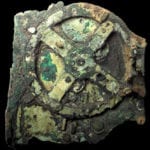 Politics
Politics  Politics
Politics  Weird Stuff
Weird Stuff 10 Eggs-traordinarily Odd Eggs
 History
History 10 Desperate Last Stands That Ended in Victory
 Animals
Animals Ten Times It Rained Animals (Yes, Animals)
 Mysteries
Mysteries 10 Devastating Missing Child Cases That Remain Unsolved
 Creepy
Creepy 10 Scary Tales from the Middle Ages That’ll Keep You up at Night
 Humans
Humans 10 One-of-a-kind People the World Said Goodbye to in July 2024
 Movies and TV
Movies and TV 10 Holiday Movies Released at Odd Times of the Year
 Politics
Politics 10 Countries Where Religion and Politics Are Inseparable
 Weird Stuff
Weird Stuff 10 Freaky Times When Famous Body Parts Were Stolen
 Politics
Politics The 10 Most Bizarre Presidential Elections in Human History
 Weird Stuff
Weird Stuff 10 Eggs-traordinarily Odd Eggs
 History
History 10 Desperate Last Stands That Ended in Victory
Who's Behind Listverse?

Jamie Frater
Head Editor
Jamie founded Listverse due to an insatiable desire to share fascinating, obscure, and bizarre facts. He has been a guest speaker on numerous national radio and television stations and is a five time published author.
More About Us Animals
Animals Ten Times It Rained Animals (Yes, Animals)
 Mysteries
Mysteries 10 Devastating Missing Child Cases That Remain Unsolved
 Creepy
Creepy 10 Scary Tales from the Middle Ages That’ll Keep You up at Night
 Humans
Humans 10 One-of-a-kind People the World Said Goodbye to in July 2024
 Movies and TV
Movies and TV 10 Holiday Movies Released at Odd Times of the Year
 Politics
Politics 10 Countries Where Religion and Politics Are Inseparable
 Weird Stuff
Weird Stuff 10 Freaky Times When Famous Body Parts Were Stolen
10 Crazy Inventions Our Grandparents Thought Were Great Ideas
We all have that cousin who is constantly hooking rockets to his bicycle, successfully inventing a way of getting himself rushed to the emergency room. Well, hard as it is to believe, those nutty cousins have actually been around for a long, long time.
10Cooking With Car Exhaust
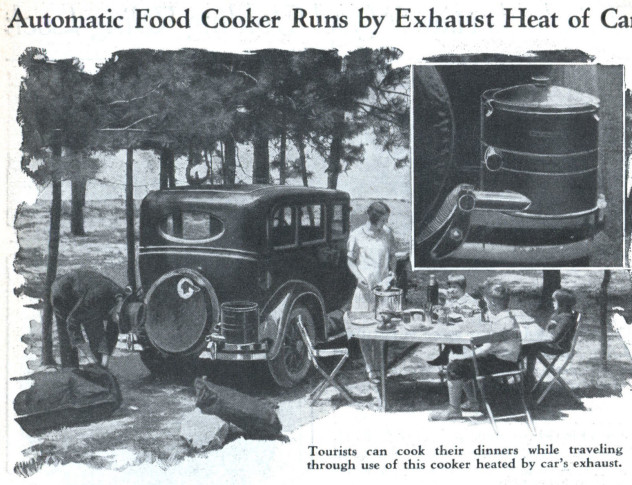
The more adventurous of us may have tried to warm up lunch by placing it atop a hot engine block. A few might even cross over to the crazy side and make a grilled cheese sandwich on the engine manifold. Well, it turns out that’s not exactly a new development—engine-cooked food has been around almost as long as the car.
Way back in June 1930, Modern Mechanix magazine featured a pressure cooker that could be mounted on the rear bumper of a car, with a hose that hooked directly to the exhaust pipe. The idea was for the “hot gases” from the exhaust pipe to heat a pressure cooker, with the inventor claiming that an hour’s drive was “sufficient to thoroughly cook meats and vegetables.” Hopefully the family’s pot roast and potatoes were kept well-sealed away from the disgusting fumes being used to cook them.
Just to prove that a bad idea never dies, a 2015 design competition saw an Iranian team submit a small grill intended to be attached to a car’s exhaust. The Iranian invention was just large enough to grill a single hamburger patty, with the clam-like design hopefully keeping the noxious exhaust away from your meat. If you’ve ever been overcome with the desire for a single, slow-cooked burger wile driving alone, then this is the invention for you.
9The Dimple-Maker
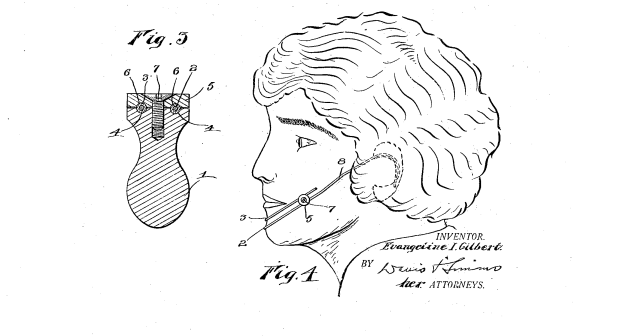
We’ve all been there: You’re heading out on a night on the town and you’ve got the perfect outfit, great accessories, and even better shoes. But the ensemble just doesn’t seem complete without a great pair of facial divots. Dimples are natural indentations, usually in the cheeks or chin, and are probably genetic, although scientists have never really cared enough to properly look into it. But what if you were born without concavities? Well, there’s always the medieval torture device known as the Dimple-Maker.
Originally patented by Evangeline Gilbert of Rochester, New York, in 1923, the device fits over the ears and chin, allowing two knobs to be screwed deeply and painfully into the cheeks. With continual use, the ad states, the user will soon be sporting “a fine set of dimples.”
The American Medical Association investigated and found that not only did the Dimple-Maker not create or enlarge dimples, it might even cause cancer. Undaunted, Ms. Gilbert tried again in 1927, when she unveiled the Medicated Beauty Ball. Essentially, the Beauty Ball was rolled over wrinkles and lines in the face, supposedly ironing them out. Yeah, that should work.
8The Plow Gun
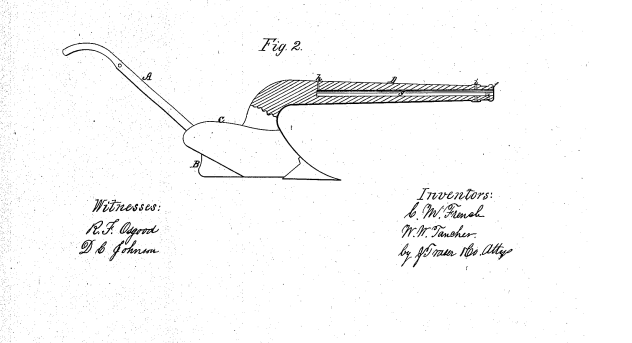
The Civil War was in its second year when two New Yorkers named Fancher and French took out a patent on a metal plow with a gun mounted on the front. The patent didn’t specify the caliber, but the gun could fire either grapeshot or 1.5-kilogram (3 lb) balls. The inventors claimed the plow would act as an anchor, limiting recoil. The whole thing would be perfect for farmers “in border localities, subject to savage feuds and guerrilla warfare.”
From the description and illustration in the patent application, it appears that the gun was extremely limited in maneuverability and could only point straight ahead. In other words, the farmer would need to unhook the horse, mule, or ox pulling the plow to avoid shooting the poor creature in the butt. Then he would need to load the gun, hoping that his attackers continued to stand still in front of the now-motionless plow. If the assailant moved, the farmer would have to muscle the plow out of its furrow and turn the entire contraption toward the target, who would probably have moved again by that point.
7The Blizzard Cone
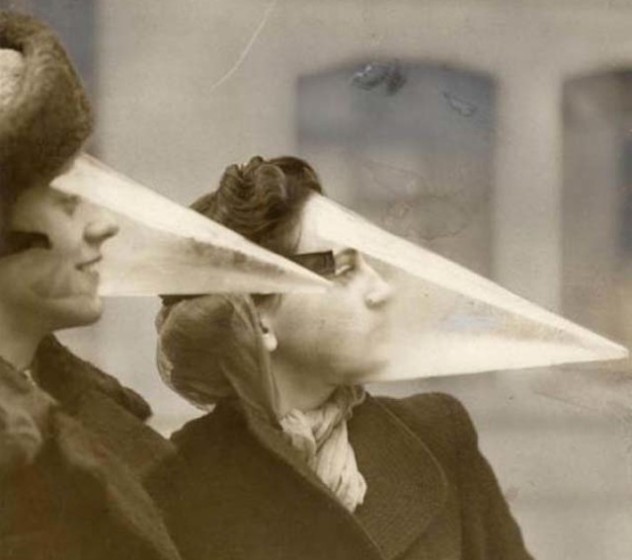
No, these aren’t two passionate fans of Mad Magazine’s Spy vs. Spy comics. They’re just a couple of fashionistas sporting Blizzard Cones, which were developed in Montreal in 1939. The cones are strapped onto a woman’s head in order to protect her makeup from the elements. Inexplicably, the cone masks never became popular. Not even in Canada.
Admittedly, it would be difficult to converse or watch your step while wearing such a contraption, but that’s a small price to pay for keeping your lipstick and blush pristine while dogsledding through a snowstorm to a swanky gala. Sure, your hair and clothes will still be at the mercy of the elements as you trek to the governor general’s soiree, but that’ll only seem like a problem until your breath fogs the mask enough for you to walk into traffic. Which is probably for the best, because by that time the temperature inside the mask will have increased enough for perspiration to wreck your makeup anyway.
6The Highway Hi-Fi
Long before satellite radio, CDs, cassettes, or even 8-track tapes, miserable motorists were forced to listen to whatever was on the local radio station at the time. That’s until the boys over at Chrysler came up with the dashboard phonograph for your car. In Chrysler’s vision, a driver growing weary of the Slim Pickens marathon on the radio could simply flip open the Highway Hi-Fi and get some vinyl groove on.
As you can imagine, Chrysler had a few problems to iron out before they introduced the system in 1956. Firstly, the unit had to be compact, making it too small to play LP records. And the smaller 45 rpm records played only one song on each side. Imagine driving down the highway and changing your 45s every five minutes.
Columbia Records ultimately came to the rescue, introducing 42 special discs, which were the size of 45s but in the 16 2/3 rpm ultra-microgroove format. The ultras provided an hour of music on each side. The problem was that you could only listen to Columbia Records artists.
But the major worry was that the Hi-Fi would have to face some literal bumps in the road. The tone arm was weighted to reduce skipping, but a pothole would inevitably dislodge it in the end, gouging the vinyl and ruining the needle. And replacement records had to be ordered directly from Columbia Records. Chrysler discontinued the system after just a year.
Chrysler tried again in 1960, this time sponsored by RCA. This time, the phonograph allowed the operator to stack as many as twelve 45s. To reduce skipping, the tone arm actually played the records upside down. It was an ingenious solution, but the records skipped anyway and Chrysler scrapped the system after only two years. Fortunately, 8-tracks became an option in 1968.
5A Double-Ended Pipe
The ’40s and ’50s were a great time to be a tobacco company. Smoking rates skyrocketed and smoking together became something of a social phenomenon. Naturally, inventors quickly came up with all sorts of ways to capitalize on it.
Take the cigarette holder for two, which premiered in 1955 and sported a pair of tubes attached to a single cigarette so that couples could cuddle while they saturated their lungs with nicotine. For smokers who selfishly wanted to suck tar all by themselves, there were holders with a built-in ashtray, holders long enough to stick out the car window, and even holders with an attached umbrella for smoking in the rain. There was even a special holder for the die-hard smoker who wanted to try smoking an entire pack of 20 cigarettes at once.
Feeling left out, pipe smokers got into the act with a double-ender pipe, which premiered in 1949. According to its developer, the pipe could be used by two smokers to conserve tobacco. The developer visualized two guys, standing face-to-face, sharing a smoke at the ballpark, suggesting a limited grasp on what men do at sporting events. Just a note to the short guy: Saliva rolls downhill.
4The Newark Steam Man
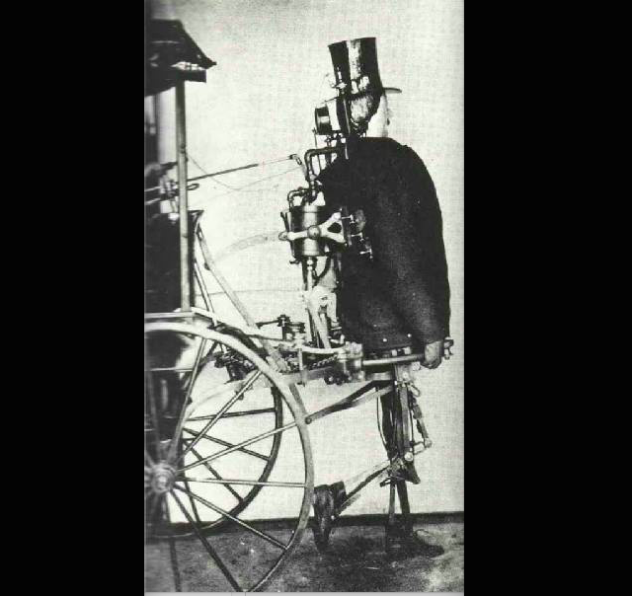
Suspend your disbelief for a moment, because the photo above is an absolutely real invention from 1868. The Newark Steam Man wasn’t the first working automaton in history, but it might well have been the most steampunk. In fact, it even inspired the first science fiction dime novel, published just months after he first appeared in the press. Sadly, the Steam Man turned out to be a failure at both its intended purpose as a replacement for the horse and its unintended purpose as a novelty.
Built by a pair of Newark mechanics, Steam Man weighed 230 kilograms (500 lb) and stood nearly 2.5 meters (8 ft) tall. Nicknamed “Daniel Lambert” after a famous obese Brit, Steam Man sported a boiler and a 3 horsepower engine in his chest cavity. When he needed to refuel, his jacket was simply opened up and coal was shoveled in. His stovepipe hat was a chimney, and he had gauges mounted on his back. He was kept upright by a rigid iron harness directly attached to a Rockaway carriage.
According to newspaper interviews, the inventors wanted Steam Man to replace horses for pulling carriages. They even hoped to build mechanical horses. But the cost of building Steam Man—about $300—was significantly more than a real horse and a bunker of coal cost considerably more than a bag of oats. The inventors claimed that Steam Man could tow a carriage at 48 kilometers per hour (30 mph), about the speed of a galloping horse. But since his stride was based on a human’s, it’s hard to see how Steam Man could have reached anywhere near that.
In order to drum up interest, the inventors took Steam Man to exhibitions in New York, Boston, Chicago, St. Louis, and New Orleans. But Steam Man was prone to technical difficulties. It had trouble negotiating cobblestones, and the vibration of the pistons that worked its legs often unbalanced it entirely. It sometimes had difficulty venting smoke out from its hat and occasionally had to be suspended from a sling for its legs to work. When Steam Man appeared in an Albany parade, his engine became so hot it had to be removed before it incinerated the whole mechanism.
Steam Man appeared in his last exhibition in Fort Wayne just a year after he was patented. A few months later, the automaton was put up for sale. It was later placed in storage and sadly disappeared from history.
3A Hands-Free Hat-Tipper
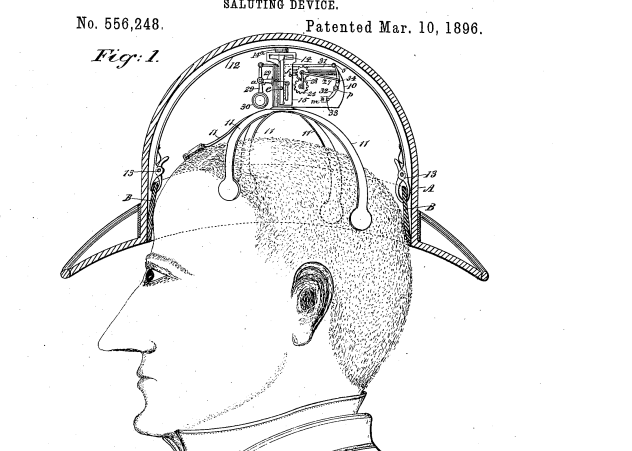
These days, we think of hands-free inventions as safety devices for drivers. But way back in 1896, they just indicated plain laziness. Take Spokane inventor James Boyle and his “saluting device,” a ridiculous gadget worn directly on a man’s head. When the gentleman in question politely bowed his head forward to greet someone, the device lifted his chapeau and tipped it forward in a polite salute. The hat then replaced itself in the proper position without ever dirtying the wearer’s mitts.
In his patent application, Boyle claimed that the device could also perform unusual hat tricks, including spinning it completely around or lifting it straight up and back down. One can imagine lecherous old men walking down the sidewalk and popping and spinning their lids whenever they ogled a pretty young lass. Add a few sound effects and circus clowns all over the world would be lining up to get their oversize gloves on the gizmo.
2The GoofyBike
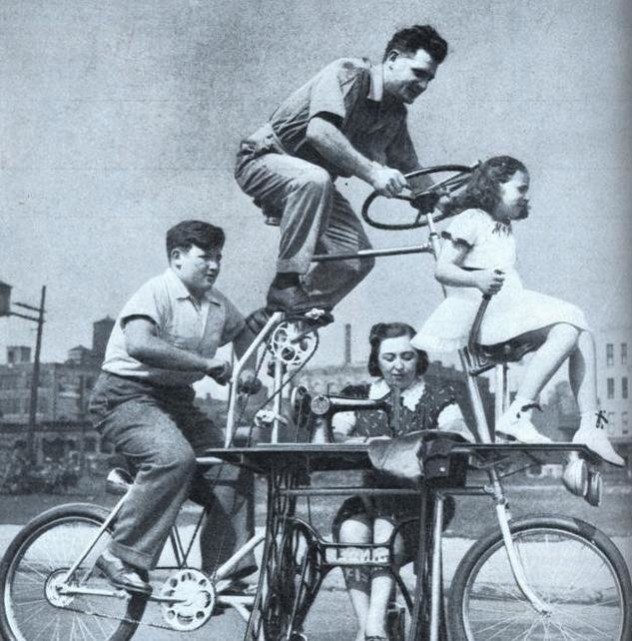
In October 1939, Popular Science magazine highlighted Charles Steinlauf of Chicago and his invention, the GoofyBike. Charles steered the contraption from his perch on top, pedaling in tandem with Junior in the back. Mrs. Steinlauf (her first name was not provided) hung off the side of the bike, calmly pumping the foot pedal beneath her to power her sewing machine. Their daughter (name also not provided) sat at the front, doing nothing. She was probably too busy worrying about how she’d be the first to know about any collisions, which helps explain why she looks like she’s about to cry in the photo.
The Popular Science feature did not specify the actual point of Steinlauf’s invention. Perhaps it’s a mending/delivery service? Or punishment for Junior ripping his pants? Or maybe it’s a father/daughter flying lesson? More likely, it was an effort by the Steinlaufs to make the cover of Popular Science. Unfortunately for them, their photo was relegated to page 133.
1The Helmet Gun
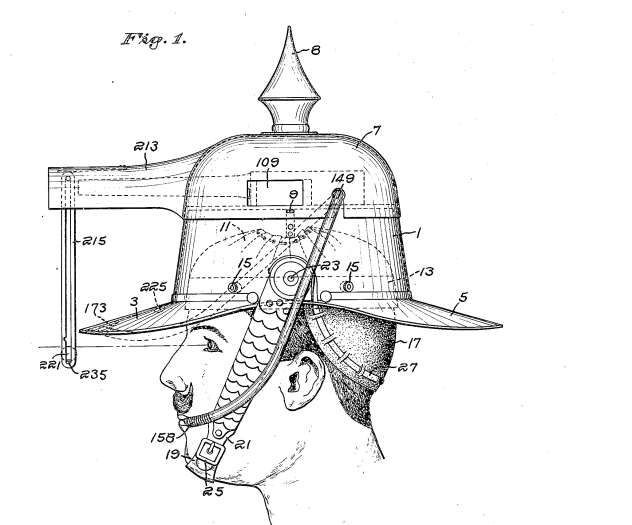
Yet another instance of an inventor mounting a gun on an unlikely object, the Helmet Gun was patented in 1916 by Albert Bacon Pratt of Vermont. Basically, a marksman strapped on a metal helmet with a gun protruding from its crown. The gun’s trigger was attached to a balloon or bladder, allowing the marksman to fire the gun by blowing into a tube, bringing a whole new meaning to blowing someone away.
Pratt claimed that his invention allowed the gunman to keep his hands and feet free for self-defense (or running if they missed their target). He also claimed that the gun’s recoil would be countered by the automatic spring back of the breech-bolt. Despite this claim, the biggest complaint from those who tested his gun was that the recoil and the noise gave them a headache and made them dizzy.
Pratt was apparently worried no one would buy his invention, since his patent application helpfully points out that the Helmet Gun could double as an excellent saucepan, using the gun barrel as a handle. Of course, if you forgot to remove the ammunition before you put your helmet/saucepan over the fire, you might blow your hand off.
Pratt’s idea never caught on, which is actually a shame considering that World War I was raging at the time. In Season 2 of Smithsonian Channel’s The Re-Inventors, the hosts demonstrated that the helmet could have been used to fire on the enemy while keeping the marksman’s head safely below the lip of his trench.
Steve is the author of 366 Days In Abraham Lincoln’s Presidency: The Private, Political, And Military Decisions Of America’s Greatest President and has written for KnowledgeNuts.
